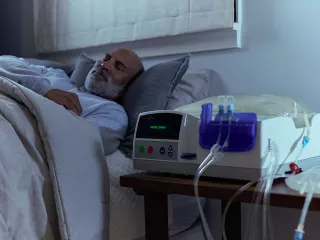
Preserving Patient Freedom With PD
Our peritoneal dialysis (PD) products and services can help people with kidney disease to maintain their chosen lifestyle. We were the first to make this therapy broadly available to patients,1 and we continue to drive it forward with a range of dialysis solutions and automated PD systems with digital connectivity. Our Sharesource Connectivity Platform for PD allows clinicians to review treatment data and take timely action.
Life goals
PD patients are more satisfied with their treatment compared to hemodialysis (HD) patients3,4
Shared decision-making
Shared decision-making supports patient satisfaction and leads to an increase in patients choosing PD5
Early survival
PD offers significant early survival benefits vs in-center hemodialysis6
Preservation of residual kidney function
PD allows a better preservation of residual kidney function than HD for patients starting dialysis, and this is associated with better patient survival7,8
Bridge to transplant
PD is associated with favorable post-transplant outcomes9
Preservation of vascular access
Initiating dialysis with PD preserves vascular access and eliminates the risk of HD access infections and complications8
Reduced infections and hospitalization rates
Evidence-based preventative strategies have significantly improved peritonitis rates over the past decade10,11
Patient candidacy
At least 78% of patients have no absolute medical or psychosocial contraindication for PD12
Addressing health disparities
Opportunity exists to increase the use of PD among African and Hispanic Americans13
Multiple therapy options
The PD therapy options that Vantive offers include continuous ambulatory peritoneal dialysis (CAPD) and automated peritoneal dialysis (APD).


CAPD therapy (manual exchange)
CAPD has several benefits in comparison to other types of dialysis. Waste products and excess fluid can be removed manually during the treatment process, which may reduce stress on a patient's body. While doing CAPD, patients may be able to eat more of the foods they enjoy and take fewer medications than if they were doing hemodialysis (HD).14
APD therapy
APD automates the delivery of dialysis solution to the patient, along with removing the excess fluid and waste. This therapy may provide increased flexibility with a patient's diet and the number of medications a patient needs to take while on dialysis.14
Vantive’s comprehensive PD portfolio includes Homechoice Claria and voice-guided Amia APD Systems, both enabled by the Sharesource Connectivity Platform.
Learn more about the Amia APD System and Homechoice Claria APD System.
Evidence supporting RPM21-24
RPM technology enhances the experience of APD. When APD is combined with RPM, the flexibility PD offers patients is further enhanced and is associated with the potential to improve clinical outcomes and adherence.
Important Safety Information
INTENDED USE
Homechoice Claria APD System is intended for automatic control of dialysis solution exchanges in the treatment of pediatric and adult renal failure patients undergoing peritoneal dialysis in the home healthcare environment including comparable use in professional healthcare facilities.
The Amia Automated PD System is intended for automatic control of dialysate solution exchanges in the treatment of adult renal failure patients undergoing peritoneal dialysis. All therapies using the Amia Automated PD System must be prescribed and performed under the responsibility of a physician who is familiar and well informed about peritoneal dialysis.
The Sharesource Connectivity Platform portal is intended for use by healthcare professionals to remotely communicate new or modified treatment parameters with compatible dialysis instruments and transfer completed treatment data to a central database to aid in the review, analysis, and evaluation of patients’ historical treatment results. This system is not intended to be a substitute for good clinical management practices, nor does its operation create decisions or treatment pathways.
Rx Only. For safe and proper use of the products mentioned herein, please refer to the appropriate Operator’s Manual or Instructions for Use.
_____
INDICATIONS AND IMPORTANT RISK INFORMATION
Dianeal peritoneal dialysis solutions are indicated for patients in acute or chronic renal failure. Please read the accompanying Important Risk Information and full Prescribing Information.
Dianeal Solution is contraindicated in patients with severe lactic acidosis.
Peritonitis has been associated with Dianeal Solution use. Following use, inspect the drained fluid for the presence of fibrin or cloudiness, which may indicate the presence of peritonitis. Improper clamping or priming sequence may result in infusion of air into the peritoneal cavity, which may result in abdominal pain and/or peritonitis. If peritonitis occurs, treat with appropriate therapy.
Encapsulating Peritoneal Sclerosis (EPS), sometimes fatal, is a complication of peritoneal dialysis therapy and has been reported in patients using Dianeal Solution.
Monitor patients with conditions known to increase the risk of lactic acidosis [e.g., severe hypotension or sepsis that can be associated with acute renal failure, hepatic failure, inborn errors of metabolism, and treatment with drugs such as nucleoside/nucleotide reverse transcriptase inhibitors (NRTIs)] before the start of treatment and during treatment with lactate‐based peritoneal dialysis solutions.
Over-infusion of peritoneal dialysis solution volume into the peritoneal cavity may be characterized by abdominal distention, feeling of fullness and/or shortness of breath. Drain the peritoneal dialysis solution from the peritoneal cavity to treat over-infusion.
Peritoneal dialysis may affect a patient’s protein, water‐soluble vitamin, potassium, bicarbonate, calcium, and magnesium levels and volume status. Monitor hematology, electrolytes, blood chemistry and fluid status periodically and take appropriate clinical action.
Potassium is omitted from Dianeal solutions because dialysis may be performed to correct hyperkalemia. In situations where there is a normal serum potassium level or hypokalemia, addition of potassium chloride (up to a concentration of 4 mEq/L) to the solution may be necessary to prevent severe hypokalemia.
Monitor fluid status to avoid hyper‐ or hypovolemia and potentially severe consequences including congestive heart failure, volume depletion and hypovolemic shock.
Dianeal Solution contains dextrose and may increase the risk for hyperglycemia in patients with impaired glucose tolerance. Patients may require initiation or modification of antidiabetic therapy during treatment with Dianeal Solution. Monitor blood glucose.
There is a potential for overdose resulting in hypervolemia, hypovolemia, electrolyte disturbances or hyperglycemia. Excessive use of Dianeal Solution with 4.25% dextrose during a peritoneal dialysis treatment can result in significant removal of water from the patient.
Please click here for full Prescribing Information.
_____
INDICATIONS AND IMPORTANT RISK INFORMATION (IRI)
INDICATION
Extraneal (icodextrin) is indicated for a single daily exchange for the long (8- to 16- hour) dwell during continuous ambulatory peritoneal dialysis (CAPD) or automated peritoneal dialysis (APD) for the management of kidney failure in patients requiring long-term kidney replacement therapy. Extraneal is also indicated to improve (compared to 4.25% dextrose) long-dwell ultrafiltration and clearance of creatinine and urea nitrogen in patients with high average or greater transport characteristics, as defined using the peritoneal equilibration test (PET).
IMPORTANT RISK INFORMATION
- Extraneal is contraindicated in patients with a known hypersensitivity to icodextrin, in patients with maltose or isomaltose intolerance, in patients with glycogen storage disease, and in patients with severe lactic acidosis.
- When measuring blood glucose levels in patients using Extraneal, do not use blood glucose monitoring devices using glucose dehydrogenase pyrroloquinolinequinone (GDH-PQQ)-, glucose-dye-oxidoreductase (GDO)-, and some glucose dehydrogenase flavin-adenine dinucleotide (GDH-FAD)-based methods because these systems may result in falsely elevated glucose readings (due to the presence of maltose). Falsely elevated glucose readings have led patients or health care providers to withhold treatment of hypoglycemia or to administer insulin inappropriately leading to unrecognized hypoglycemia. Falsely elevated glucose levels may be measured up to two weeks following cessation of Extraneal therapy when GDH-PQQ-, GDO-, and GDH- FAD-based blood glucose monitors and test strips are used. Additionally, other glucose-measuring technologies, such as continuous glucose monitoring systems, may or may not be compatible with Extraneal. Always contact the device manufacturer for current information regarding compatibility and intended use of the device in the dialysis patient population.
- Extraneal is intended for intraperitoneal administration only. Not for intravenous or intra-arterial administration. Aseptic technique should be used throughout the peritoneal dialysis procedure.
- Encapsulating peritoneal sclerosis (EPS), sometimes fatal, is a complication of peritoneal dialysis therapy and has been reported in patients using Extraneal.
- Serious hypersensitivity reactions to Extraneal have been reported such as toxic epidermal necrolysis, angioedema, serum sickness, erythema multiforme and vasculitis. Anaphylactic or anaphylactoid reactions may occur. If a serious reaction is suspected, discontinue Extraneal immediately and institute appropriate therapeutic countermeasures.
- Overinfusion of peritoneal dialysis solution volume into the peritoneal cavity may be characterized by abdominal distention, feeling of fullness and/or shortness of breath. Drain the peritoneal dialysis solution from the peritoneal cavity to treat overinfusion.
- Patients with insulin-dependent diabetes may require modification of insulin dosage following initiation of treatment with Extraneal. Monitor blood glucose and adjust insulin, if needed.
- Peritoneal dialysis may affect a patient’s protein, water-soluble vitamin, potassium, sodium, chloride, bicarbonate, and magnesium levels and volume status. Monitor electrolytes and blood chemistry periodically. Monitor fluid status to avoid hyper- or hypovolemia and potentially severe consequences including congestive heart failure, volume depletion, and hypovolemic shock. Abnormalities in any of these parameters should be treated promptly under the care of a physician.
- In clinical trials, the most frequently reported adverse events occurring in ≥10% of patients and more common in Extraneal PD solution patients than in control patients, were peritonitis, upper respiratory infection, hypertension, and rash. The most common treatment‐related adverse reaction for Extraneal PD solution patients was skin rash.
Click here for full Prescribing Information for Extraneal PD Solution.
Vantive, Amia, Dianeal, Extraneal, Homechoice Claria and Sharesource are trademarks of Vantive Health LLC or its affiliates.
References
-
Guest S. Handbook of Peritoneal Dialysis. CreateSpace Independent Publishing Platform; 2010:9.
-
François K, Bargman JM. Evaluating the benefits of home-based peritoneal dialysis. Int J Nephrol Renovasc Dis. 2014;7:447-455.
-
Lee SW, Lee NR, Son SK, et al. Comparative study of peritoneal dialysis versus hemodialysis on the clinical outcomes in Korea: a population-based approach. Sci Rep. 2019;9(1):5905.
-
Zazzeroni L, Pasquinelli G, Nanni E, Cremonini V, Rubbi I. Comparison of quality of life in patients undergoing hemodialysis and peritoneal dialysis: a systematic review and meta-analysis. Kidney Blood Press Res. 2017;42(4): 717-727.
-
Devoe DJ, Wong B, James MT, et al. Patient education and peritoneal dialysis modality selection: a systematic review and meta-analysis. Am J Kidney Dis. 2016;68(3):422-433.
-
Marshall MR. The benefit of early survival on PD versus HD—why this is (still) very important. Perit Dial Int. 2020;40(4):405-418.
-
Bargman JM, et al. Relative contribution of residual renal function and peritoneal clearance to adequacy of dialysis: a reanalysis of the CANUSA study. J Am Soc Nephrol. 2001;12(10):2158-2162.
-
Almasri JM, et al. Outcomes of vascular access for hemodialysis: a systematic review and meta-analysis. J Vasc Surg. 2016;64(1):236-243.
-
Joachim E, et al. Association of pre-transplant dialysis modality and post-transplant outcomes: a meta-analysis. Perit Dial Int. 2017;37(3):259-265.
-
Marshall MR, et al. A systematic review of peritoneal dialysis-related peritonitis rates over time from national or regional population-based registries and databases. Perit Dial Int. 2022;42(1):39-47.
-
United States Renal Data System. 2021 USRDS Annual Data Report: Epidemiology of kidney disease in the United States: End Stage Renal Disease: Chapter 5. Hospitalization. National Institutes of Health, National Institute of Diabetes and Digestive and Kidney Diseases.
-
Mendelssohn DC, et al. A prospective evaluation of renal replacement therapy modality eligibility. Nephrol Dial Transplant. 2009;24(2):555-561
-
United States Renal Data System. 2018 USRDS Annual Data Report: Epidemiology of kidney disease in the United States: End Stage Renal Disease: Chapter 1. Incidence, Prevalence, Patient Characteristics, and Treatment Modalities. National Institute of Diabetes and Digestive and Kidney Diseases.
-
National Kidney Foundation. Peritoneal dialysis. 2024. Accessed September 20, 2024. https://www.kidney.org/kidney-topics/peritoneal-dialysis.
-
Firanek C, Knowles MA, Sloand JA. The impact of automated peritoneal dialysis (APD) with remote patient management (RPM): changing the nursing paradigm to proactive clinical management (SP508). Poster presented at: 54th ERA-EDTA Congress; June 3-6, 2017; Madrid, Spain.
-
Firanek C, Salas M, Gellens M, Gatesman RD, Wiebenson D, Sloand J. Discrepancy between prescripted and actual APD prescription delivery: identification using cycler remote management technology (MP-557). Poster presented at: 54th ERA-EDTA Congress; June 3-6, 2017; Madrid, Spain.
-
Makhija D, Alscher MD, Becker S, et al. Remote monitoring of automated peritoneal dialysis patients: assessing clinical and economic value. Telemed J E Health. 2018;24(4):315-323.
-
Rivera AS, Sanabria M, Vesga J, Suarez AM, Bunch A. Comparison of hospitalization rate in automatized PD patients with and without remote management program in Colombia. J Am Soc Nephrol. 2018;29:595-596.
-
Corzo L, Vesga J, Sanabria M, Rivera A. Clinical outcomes in remote patient monitoring in automated peritoneal dialysis: a Colombian experience. Nephrol Dial Transplant. 2020;35(suppl 3):gfaa142.P1151.
-
Sanabria M, Vesga J, Lindholm B, Rivera A, Rutherford P. Time on therapy of automated peritoneal dialysis with and without remote patient monitoring: a cohort study. Int J Nephrol. 2022;2022:8646775.
-
Firanek C, Salas M, Gellens M, Gatesman RD, Wiebenson D, Sloand J. Discrepancy between prescribed and actual APD prescription delivery: Identification using cycler remote management technology. Neph Dial Trans. 2017;32(suppl 3):iii633.
-
Sanabria M, Buitrago G, Lindholm B, et al. Remote patient monitoring program in automated peritoneal dialysis: impact on hospitalizations. Perit Dial Int. 2019;39(5):472-478.
-
Wood E, McCarthy K, Roper M. Remote monitoring of peritoneal dialysis: evaluating the impact of the Claria Sharesource system. J Kidney Care. 2019;4(1):16-24.
-
Firanek C, Knowles M, Sloand J. Impact of remote patient management in hospitals conducting APD: shifting the nursing care paradigm. Neph Dial Trans. 2017;32(suppl 3): iii300.




